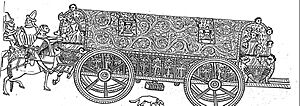Verge (royal court) facts for kids
The verge was a special area, like a bubble, that stretched about 12 miles around the English king or queen's court. This area had its own unique legal rules for certain things. A special court called the Court of the Verge handled legal cases that happened within this area or involved people from the Royal Household.
The Coroner of the Household was in charge of investigating any deaths that occurred inside the verge. Also, the Clerk of the Market had power over markets held within this special zone. The Board of Green Cloth used to issue official papers to arrest people in the verge. Later, they became responsible for giving out special permissions, like licenses.
Contents
What Was the Verge?
Long ago, in medieval times, the English royal court didn't stay in one place. The king or queen and their many helpers were always moving around the country. This was called an itinerant court.
An important person called the Knight Marshal traveled with the monarch. The Knight Marshal carried a special stick, or "wand," which showed the king's power and justice. This wand was sometimes called the "verge wand."
The area around this wand, within a 12-mile circle, became known as the verge. It was a special zone where different laws applied. Some old records say the 12 miles was around the edge of the circle. Other records say it was measured from the wand outwards, like a radius. This radius definition was used when the court finally settled in London.
The word "verge" also described the royal court itself. People who were part of the court were sometimes called "vergours." The word "verge" comes from the idea of a "circle" or "boundary."
Special Rules in the Verge
The Court of the Verge
People in England could ask the royal court to hear cases about problems that happened within the verge. To handle these cases, a special Court of the Verge was usually set up. The Lord Steward, another important person in the Royal Household, would typically call this court.
This court handled crimes committed in the verge. It also dealt with any cases involving members of the Royal Household. The Knight Marshal helped the court by taking care of any prisoners. A Clerk of the Verge also assisted the court.
Once, in 1290, Edward I even fined himself! He had hit one of his squires during his daughter Margaret's wedding party. After the royal court stopped moving and stayed in London, the Court of the Verge became the Marshalsea Court. This court had a fixed location in Southwark.
The Coroner of the Household
The Coroner of the Household was the person who investigated deaths that happened inside the verge. Regular county coroners were not allowed to investigate deaths in this special area. However, the Coroner of the Household often worked with the local county coroner.
Later, when the royal court mostly stayed in Westminster, the person who was the Coroner of the Household was also often the coroner for Middlesex. This was the county where the court was located. This helped to avoid confusion about who had the right to investigate.
The Clerk of the Market
The Clerk of the Market was originally in charge of the markets right outside the king's home. Their job was to make sure the Royal Household could get supplies. From 1290, the clerk was allowed to travel within the verge. They visited other markets as the court moved around.
The law said that the clerk's preferred weights and measures had to be used in the markets they visited. The clerk could fine people or even stop a market from meeting if it didn't follow the rules. The clerk made a lot of money from fines.
The Board of Green Cloth
The Board of Green Cloth was first responsible for issuing arrest warrants within the verge. This means they could officially order someone's arrest in that area. Even into the 21st century, the Board still had a role. They gave out licenses for things like selling drinks or gambling in places controlled by the royal palaces. This role ended when the Licensing Act 2004 was passed.
Images for kids


